Work
-
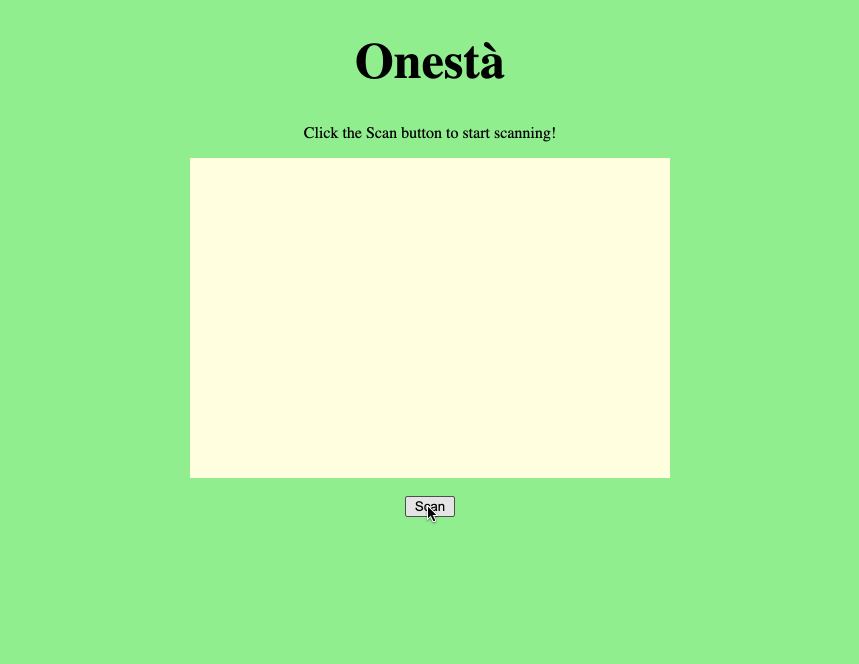
Onesta
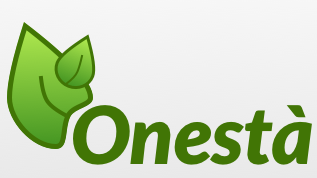
Onesta is a Flask application that was birthed at HackNYU 2019 by five individuals. Onesta scans a product's barcode and returns the name, brand and ingredients of the product. I used JavaScript library QuaggaJS and a mode function to read the product's barcode from a webcam/phone camera. Given the product's barcode, I called the Nutritionix API and extracted the wanted data, ultimately displaying the results in HTML.
Challenges:
- Originally, the purpose of this project was to provide more information on those hard-to-pronounce ingredients in an attempt to teach users' about the food they put into their body. Unfortunately, it was difficult to find a public database with information on these ingredients, so we decided to drop the explanation part. However, it was also difficult finding a FREE API that gives nutrition information for a product given a barcode at the time of this project's creation. Nutritionix is not entirely free (has limitations). I've learned of other options such as Open Food Facts that exist.
- I used a JavaScript library to read the barcodes and Flask to make an API call. This meant using JQuery's post method to call the '/barcode' route function in Flask and use jQuery replaceWith() method to replace some HTML with the response from Flask (since render_template refreshed the page, therefore losing the data from API call). In the future, I believe it would be better to use a JavaScript-based web framework such as Node.js
-
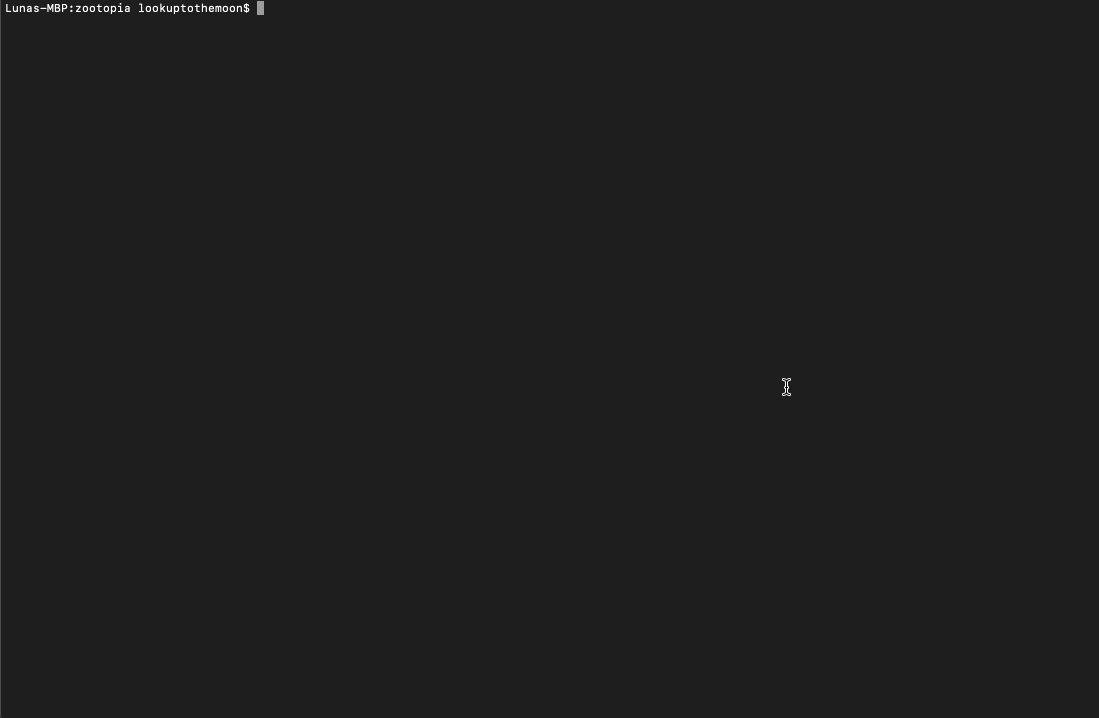
Zootopia
Zootopia was made by 4 high school kids (including myself) in order to apply skills learned in computer science class. Zootopia, loosely based on the famous animated film, is a text adventure game where Sterny the Squirrel travels the world of Zootopia to find his stolen goods. As Sterny travels across all the burrows of Zootopia, he gives the user a list of suspects, in which the user must guess who the bandit is. If the user guesses the bandit correctly, they retrieve a golden acorn (revealed at end). The purpose of the game is to collect all of Sterny's stolen golden acorns.
The code for this game included classes such as Location for each burrow, Map for mapping of locations (in terms of order), Player for characters in the game, Suspect for suspected bandits, and a Game Engine to control flow of game.Challenges:
- This collaborative project required that communication was made between all teammates. Initially, we thought it would be best to divide and conquer the classes needed for our proposed plan. However, we did not take into consideration merging our code together until much later. This resulted in a lot of syntax errors, but also taught us what it means for several people to collaborate on a project together.
Skills: Object-oriented programming, game design, inheritance (parent/child classes), code orginization, finite state machines, communication and collaborative programming. -
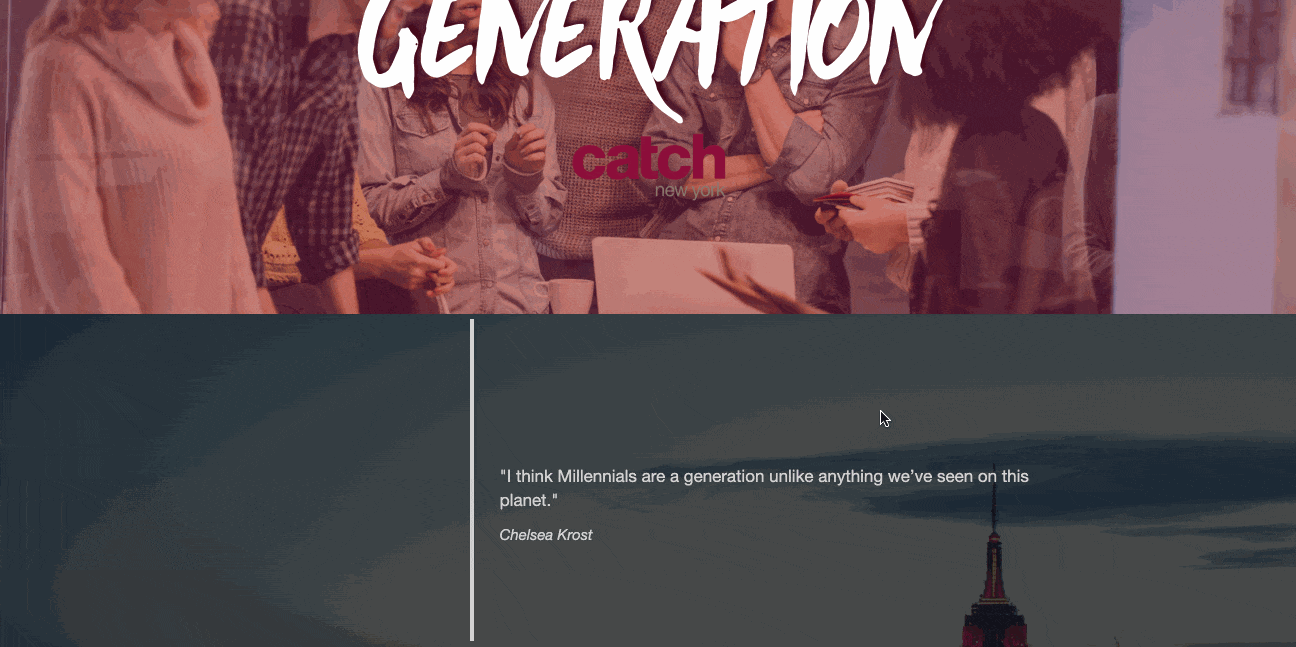
A Filtered Generation
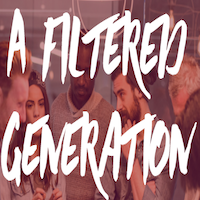
A Filtered Generation (AFG) was a project created during my internship at CATCH NYC in 2016. I had previosly held an internship where I did some coding work, but CATCH NYC was the first place where I worked with non-coders to creating a website (a small coding project). I collaborated with three design interns to create a responsive landing page, showcasing research done on millenials.
Challenges:
- I had never collaborated on a project where I had to explain technical terms to non-coders. I struggled to find the language needed to communicate with these three design interns. For example, I was given a .psd file highlighting the layout for the landing page, including text images. I wasn't sure what I was supposed to do with the file, so I asked another web developer colleague to help guide me through the process. Turns out, I needed more than the .psd file to complete the project (i.e. raw text and fonts, imgs, etc.). Overall, I learned what was possible in web development but also what deliverables to expect from a client.
- I was responsible for creating the project from scratch and deciding how the project was going to be built. I did not have much experience in web development at the time so doing this was a struggle. I did not know a lot about hosting, using JavaScript libraries, etc. Aside from asking my web developer colleagues, I used my documentation-reading skills to figure out how to implement the neccessary functions needed for the project (also, thousands of ways on how not to do things). Fortunately, I was able to complete and present my part of the project in a timely manner.
Built with: HTML, CSS, JavaScript (Greensock, ScrollMagic), GitHub PagesSkills: Cross-functional communication, collaboration, problem solving, being resourceful
-
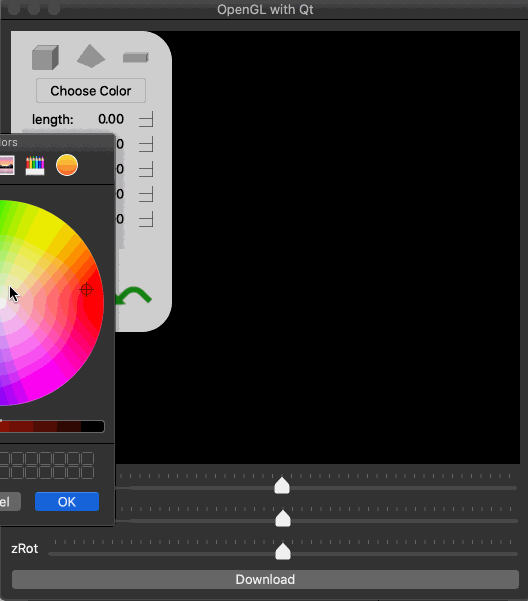
FoodCAD
FoodCAD is a smaller project created as a part of the Digital Food research project team in the Creative Machine Lab at Columbia University. FoodCAD is a CAD program intended to be used with the Digital Food team's custom-built food printer, a printer that 3D prints edible materials. FoodCAD allows users to be able to create edible 3D models. It is supposed to provide users with a user-friendly user-interface that shows the true representation of the models they are creating.
Challenges:
- It was difficult finding a open-source project that would allow us to create our own FoodCAD program that would give us exactly what we needed and was easy to use. Initially, we tried to use FreeCAD but not only had trouble figuring out how to install/run the program, but also had trouble understanding the immense amount of code. We decided that FreeCAD hadway more functions than we needed so we decided to go with the Qt toolkit.
- The OpenGL library wasn't too difficult to work since I had used it before in my Computer Graphics class. However, Qt Creator was very difficult to use at first. From the couple of hours I had to allocate just to download the application, I also spent a few hours trying to connect my code to the UI components. This was by far one of the most difficult projects I have had to figure out. I initially was working on this project with another partner, but . Overall, I can't compain. I was able to accomplish so much from this project. From applying the linear algebra skills I learned in the classroom and trying to figure out how to create this program with little documentation, I was able to find a way to create an innovative real-world application.
- I could not figure out how to identify the correct vector points for the 3D objects created by the user, therefore not being able to create an .stl file for the user to download. I was able to figure out how to download a simple 3D cube but did not know how to correctly translate that into other shapes.
- It is not possible to export a Qt Creator project. Therefore, in order to see/edit the project itself, one must download Qt Creator. Also, I believe the application (.exe) only works in Windows.
-
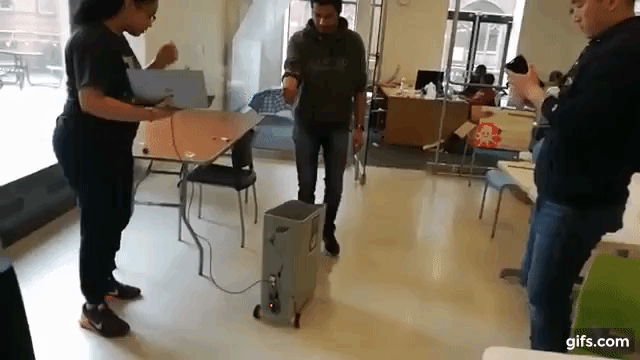
I Opt Trash (IOT)
During a MAKECU Hackathon, I teamed up with three participants to optimize a trash can. Using an Arduino and Myo Gesture Control Armband, we were able to move a trash can in different directions with simple hand gestures.
I Opt Trash (IOT) came about after having spent several hours on attempting to solve another problem. Initially, we wanted to create a Code Anywhere Virtual Reality application using the Oculus Rift. The user would be able to transport anywhere in the world and code on a virtual keyboard. Unfortunately, the Oculus Rift required a heavy machine to work on and the hackathon sponsors did not have the right equiptment. After spending a few hours trying to get that to work, we decided to change our project. After only a few hours of work, we grew tired. We thought, what's a problem we can solve? It doesn't have to be big but should allow people to be more lazy (lol!). While joking about this, we saw that our table was being filled with more trash by the minute. We thought, "What if we could make the garbage can move towards us so that we don't have to get up to throw it away?!" Thus, I Opt Trash (IOT) came along.
We won the Judge's Choice Award out of more than 10 other groups.
Challenges:
- The Myo Gesture Control Armband was a great and easy tool to used but after hours of development and testing, the armband started to stretch out and decreases in reliability. There were times when the armband would read the signals and act as expected and there were times when it simply did not respond. This ultimately did not lead to the best results during our live demo (good thing we had a video).
- The wheels and motors used for our trash can were not strong/powerful enough to handle the weight of the trash can. We tried cutting the trash can down to decrease its weight, which helped a lot. However, it was not enough for some surfaces that were harder to travel on (i.e. carpet). Ultimately, this issue led to some time spent in the Makerlab modifying parts and build connectors.
Built with: Arduino, Myo Gesture Control Band